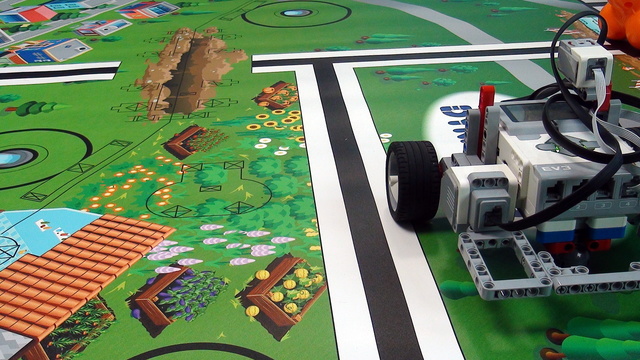Should the robot be with a Front Wheel Drive or a Rear Wheel Drive to make it more precise? The answer is - front wheel will probably give you better results, but the wheel drive is not the most important thing. In this video tutorial on the LEGO Mindstorms Robots, we will do a few experiments to discuss the influence of the wheel drive on the precision of the movement.
- #651
- 09 Jan 2018
- 3:27
- LEGO MINDSTORMS, LEGO MINDSTORMS EV3
- Move straight, FIRST LEGO League, Box Robots, EV3, Physics, FLL, Construction
A very popular construction on our platform is the Rear wheel drive construction from the FLL Robot Chassis section from the FIRST LEGO League course. So if you need an example for a construction with a Rear Wheel Drive, just check it out.
Move forward
Given our Box Robot when it moves forward it actually has a Front Wheel Drive.
Move backwards
When our robot moves backwards it actually has a Rear Wheel Drive
Front and Rear wheel drive or 4x4
It is possible to build a robot with front and rear wheel drive or to build a robot with 4x4, or two have a differential on the axles. But you have to decide whether it is worth it depending on the requirements for size and complexity that you have.
Five Minute Bot
Building instructions for a LEGO Mindstorms EV3 Robot that we call the Five Minute Bot because it could be built in Five Minutes.
Note: If the robot is making inconsistent turns due to the floor, modify the castor wheel so it is placed further back in the construction. Thus the center of mass falls more over the tires and the turns are more consistent.
EV3 Base Chassis 4 - Back Wheels Reversible Motor
Building instructions for a LEGO Mindstorms Base Chassis with a reversible motor
Note: This robot contains wheels that are from the NXT set.
LEGO Box Robot Three - with three light sensors and one Gyro
This is a real competition robot with three light sensors and a gyro.
English
Our next step in the process of finding the answer how to make the LEGO robots move straight ahead is to discuss front-wheel drive and rear-wheel drive. Should the robot be with a front-wheel drive or with a rear-wheel drive to make it more precise, more stable, more predictable. The answer is that a front-wheel drive will probably give you better results but the wheel drive is not the most important thing. In this video tutorial on the LEGO Mindstorms robots we'll do a few experiments to discuss the influence of the wheel drive on the precision of the movement. Here we have the Box Robot and the Five Minute Robot. And the Box Robot is generally with a rear-wheel drive. This means that the wheels are at the back of the robot. And the wheels push the robot forward. How do you build a front-wheel drive? You actually just turn the robot. And now if you decide that this is your front of the robot and when you are moving forward, you should move in this direction then this becomes a front-wheel drive because now the wheels are at the front of the robot and they pull on the robot while they are moving. So, this is a front-wheel drive and this is a rear-wheel drive. And the same applies for the Five Minute Bot. If we think that this is our front, then we have a front-wheel drive but if we just turn the robot and if we now think that this is the front of our robot, then we have a robot with a rear-wheel drive. So, there is nothing special about constructing rear or front. You just have to decide on the direction in which you would like say that your robot will move forward. What we'll do as an experiment in this video is to take the Five Minute Bot and to move with the Five Minute Bot when we have the wheels at the back so as a rear-wheel drive. And it will move in this direction and we'll see the deviation of the straight line. And then we'll take the Box Robot and this Box Robot generally has a rear-wheel drive so we'll just turn it like this and it will move in this direction and again we'll see the deviation from the straight line.
As you could see the robots still make errors. And they still deviate from the straight line even though that we change from front to rear and from rear to front-wheel drive. They still make errors. So, probably it is important for your robot but generally if you have a robot that's well balanced, whether you have a front-wheel drive or a rear-wheel drive should not matter.
Courses and lessons with this Tutorial
This Tutorial is used in the following courses and lessons

Moving Straight with LEGO Mindstorms EV3 robots
One of the most controversial topics when it comes to LEGO Mindstorms robots is how to make them move in a straight line. This is a problem that has caused a lot of confusion among teachers, parents, rookie teams and students. The robot makes about 2-3 centimetres error for every meter, which is about an inch for every 3-4 feets. In this course, I would like to discuss the different ways in which you can improve the behaviour of the robot and how you could make it move in a straight line with the help of the LEGO Mindstorms EV3 Gyro Sensor.
- 24
- 102:09
- 3

Understanding the issues with moving straight
The balance of the construction of the robot has a great influence on how it will move. This is especially true if you would like to move in a straight line. If the robot is slightly heavier on the right it will move to the right. Here we have two robots - a Five Minute robot and a Box Robot and we will discuss the differences in the constructions and why the box robot is much better than the Five Minute even though it is using the same parts.
- 6
- 0
- 0
- 3d_rotation 2


